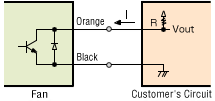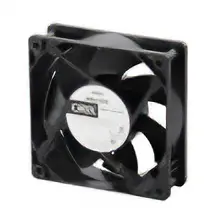Please Tell Me About Fan Alarm Circuits!


-

Mr. Vex! What are you doing?
-

I'm checking the equipment in the showroom to make sure it's working properly. The cooling fan is also working fine!
But Ms. Ori, in the case of this showroom, it's good that the fan is attached to a place where it can be easily seen, but if it were out of sight or very far away, it would be a hassle to go and check it. Isn't there an easier way to check?

-

Good idea. You've got a good point. It's not always the case that a person is always present wherever there’s an equipment!
In that case, it's a good idea to recommend a fan with an alarm circuit. -

Alarm circuit? Is that an alarm that goes off when the motor stops?
-

There are different types of alarm circuits.
-

I see.
-

There are 3 types of circuits: (1) rotation deterioration detection type (no contact and contact), (2) rotation stop detection type, and (3) pulse sensor output circuit, and each alarm method are different.
-

There are so many types and it’s confusing. How do I know which one to use?
-

It depends on the timing when you want the fan to output an alarm.
-

Hmmm.
-

For example, the (1) rotation deterioration detection type is recommended when there is a possibility that there will be an equipment failure due to deterioration in the rotation speed of the fan. On the other hand, if it is okay to deal with the problem after the fan has stopped, the rotation stop detection type (2) is suitable. The pulse sensor output circuit in (3) is useful when you want to monitor the rotation speed of a fan. The output pulses allow us to keep track of the rotation speed, so fan abnormalities can be ascertained in real time. I'd recommend this if a small drop of speed would adversely affect the equipment.
-

Hmm, there are many different types.
-

For example, in the case of the (1) rotation deterioration detection type, voltage is applied externally, and the alarm is detected by turning the internal circuit ON and OFF. Take the MRS Series large high static pressure fan with a frame size of 250 mm as an example.
* Electronic alarm type (Open collector method) 
When the rotation is normal, it turns ON (Open-collector output: low level), and when the rotation deteriorates, causing alarm output, it turns OFF (Open-collector output: high level).
-

I see. Do the other (2) and (3) detect alarms in the same way?
-

All types are the same in the sense that voltage is applied externally. However, there may be slight differences depending on the product and the type of alarm circuit, so please check the specifications of each product.
-

Gotcha. With this alarm output, I don't have to check the fan every morning! Even if something get caught in the fan blades and the fan stops, it is a relief that we’ll be made aware of it.
-

Good idea.
-

But, Ms. Ori... If the fan locked, will the fan burnout?
-

It’s okay because AC fans are impedance protected or have built-in thermal protectors, and DC fans have built-in burnout prevention circuits that provide overheat protection.
- * For overheat protection specifications, please refer to the page for each specification in the general catalog or the Technical Reference.
-

I see. Then I guess I'll make a new demonstration unit using a fan with an alarm circuit.
-

Don't try too hard, and don't output the alarm, Vex.
-

Oh, give me a break, Ms. Ori!!
